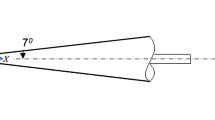It is noted that losses during flow along the surface is the basic form of loss in hydrocyclones. The special role of the axisymmetric frontal effect, which results in vigorous longitudinal circulation that transfers losses from the boundary layer to the core of the flow, is demonstrated. The velocity and pressure distribution along the radius is determined from the equality of the losses on the surface and in the core of the flow, but in the axial direction, it is determined on the basis of the principle of maximum flow rate. A model of the flow in the conical zone of a hydrocyclone, which makes it possible to determine the narrowing of the air column toward the vertex of the cone and the flow rate through the slime opening is created. An explanation is given for a number of anomalous hydrodynamic phenomena.
Similar content being viewed by others

References
I. G. Ternovskii and A. M. Kutepov, Hydrocycloning [in Russian], Nauka, Moscow (1994).
A. M. Fominykh and S. F. Mochalkin, “Influence exerted by the sides of the inner surface and its roughness on the hydrodynamics of the flows and outputs of hydrocyclones,” Collection of Works Presented at the First All-Union Conf. on Hydrocyclones [in Russian], edited by V. V. Naidenko, Gorkii (1981), pp. 145–148.
V. Yu. Zhityannyi and I. Ya. Khusainov, “Analytical relationships for determination of flow-rate characteristics with consideration of internal-surface roughness in pressurized hydrocyclones,” Collection of Works Presented at the First All-Union Conf. on Hydrocyclones [in Russian], edited by V. V. Naidenko, Gorkii (1981), pp. 249–252.
R. N. Shestov, Hydrocyclones [in Russian], Mashinostroenie, Leningrad (1967).
S. G. Valyukhov, V. V. Khodus, and S. V. Yaroslavtsev, “Application of the principle of maximum flow rate and energy-balance method for analysis of hydrocyclones,” Konvers. Mashinostr., No. 5, 27–34 (2004).
S. G. Valyukhov and V. V. Khodus, “On hydrodynamic paradoxes in hydrocyclones,” Konvers. Mashinostr., No. 6 (2006).
M. A. Goldshtik, Eddy Flows [in Russian], Nauka, Sibirskoe Otdelenie, Novosibirsk (1981).
Yu. F. Dityakin, L. A. Klyachko, B. V. Novikov, and V. I. Yagodkin, Atomization of Liquids [in Russian], Mashinostroenie, Moscow (1977).
Author information
Authors and Affiliations
Additional information
Translated from Khimicheskoe i Neftegazovoe Mashinostroenie, No. 2, pp. 7–9, February, 2009.
Rights and permissions
About this article
Cite this article
Khodus, V.V. Improving the accuracy of hydrocyclone analysis by accounting for transfer of hydrodynamic losses from the boundary layer to the core of the flow. Chem Petrol Eng 45, 63–68 (2009). https://doi.org/10.1007/s10556-009-9144-9
Published:
Issue Date:
DOI: https://doi.org/10.1007/s10556-009-9144-9



